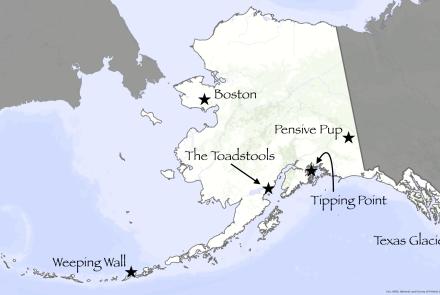Summertime's Sound and Light Show
A distant flicker and grumble to the northeast told me the weathermen had it right. Scattered thunderstorms had formed over the Tanana Uplands, and the sultry afternoon sky was getting pretty lively. Now, if I could only remember the trick for telling how far away the storm was...
The Weather Book is my favorite quick source on weather-related matters. Author Jack Williams has studied meteorology, but it's his journalism work with the weather page for "USA Today" that led to the book. According to Williams, we see the lightning's flash the instant it strikes---which is reasonable, since it travels at the speed of light. By comparison, sound dawdles on its way to us. It takes about five seconds for the thunderous sound of a lightning strike to reach a mile away.
Properly, the form of rowdy weather that produces this sound and fury should be called a lightning storm rather than a thunderstorm because lightning is what causes thunder. Apparently the real cause of a storm's rumbling is heat.
Most people have a general understanding of lightning basics. Typically, a negative charge builds up in the cloud and a positive charge builds up on the ground. Electrons, which carry a negative charge, begin zig-zagging downward in an invisible, jagged flow. When they meet an upward-flowing streamer of positive charge, a current begins to flow. That's a very calm way of describing the titanic force of the upward leap of intense positive charge that makes up the lightning stroke we see.
Yes, lightning really does strike up. At least that' s the most visible component of the fast up-and-down exchange making up a lightning bolt. The upward charge moves at nearly 60,000 miles a second, and the whole process can repeat several times along the same path in less than half a second.
This is where the effect of heat comes in. The visible return stroke is enormously hot, near 50,000 degrees Fahrenheit. The air through which it passes heats up instantly, to several tens of thousands of degrees F. It expands, rushing outward. It loses heat quickly to the surrounding air, contracting again as it cools. It's this to-and-fro stampede of stressed air molecules that makes the racket we associate with thunderstorms. The high-speed movement of air expanding and contracting around lightning generates the sound waves that reverberate through the air between us and the lightning.
Exactly how that racket sounds in our ears depends on how close we are to the lightning. The good news is that if you hear thunder, you haven't been killed by the lightning. However, the deafening Crrack! of a nearby bolt can leave listeners thinking perhaps that they've heard the crack of doom---and probably unable to hear much else until their ears recover.
Thunder's characteristic rumble comes with distance. The first sound we hear was generated by the closest part of the lightning, usually the section near the ground. Then the sound waves generated by the more distant portions of the stroke come rolling in, further complicated by sound waves from any forks in the bolt and overlaid by the waves from multiple returns.
Even though the hot summer of 1993 has given Alaska an unusually good crop of thunderstorms, our state is in the low-frequency realm of storm occurrence. Like Hawaii and the Pacific Northwest, Alaska has typically fewer than 20 days with thunderstorms in the course of a year. (That's an average for the whole state; portions of Alaska, such as the western Aleutians, probably come closer to one day of thunderstorms every 20 years.) The eastern shores of the Gulf of Mexico seem to be the ideal thunderstorm habitat with the area inland from Tampa, Florida, holding the world championship. Floridians in that area can expect thunderstorms on more than 100 days each year.



